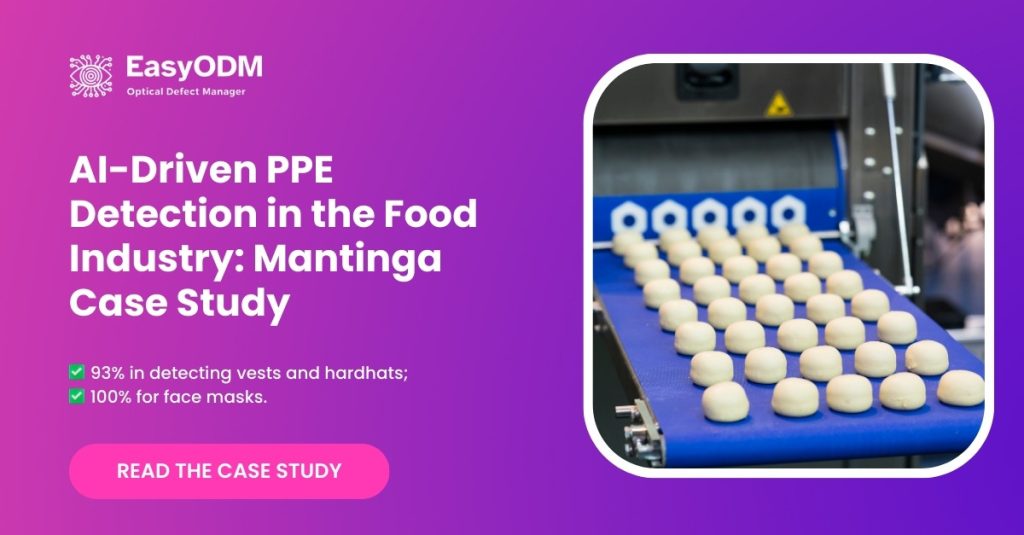In an industry where safety and compliance are important, Mantinga, a key player in the Baltic frozen and convenience food industry, has taken a significant leap forward by integrating an AI-powered Personal Protective Equipment (PPE) detection system.
This case study delves into the unique challenges faced by Mantinga, which other computer vision companies struggled to solve and the innovative AI solutions implemented by EasyFlow.
Client Background
Established in 1995 in Lithuania, Mantinga UAB has grown to become a vital player in the regional food manufacturing industry.
With a commitment to quality and innovation, the company has consistently pushed boundaries to maintain its standing in a highly competitive market.
Employing over 1600 employees in 2023, Mantinga has demonstrated its resilience and capacity for growth, underpinned by a strong foundation in operational excellence and a commitment to safety standards.
Frozen and Convenience Food Industry
The global frozen food market, a dynamic and rapidly expanding sector, has been experiencing significant growth.
According to Fortune Business Insights, the global frozen food market size was $285.18 billion in 2022 and is projected to grow from $297.47 billion in 2023 to $412.93 billion in 2030, exhibiting a CAGR of 4.80% during this forecast period.
This growth trajectory is fueled by evolving consumer preferences for convenience and quality, challenging manufacturers to maintain high standards of safety and efficiency in production and logistics.
The Safety Challenge in Food Manufacturing
For Mantinga, ensuring consistent compliance with PPE protocols across various operational settings, including manufacturing plants and logistics centers, presented a significant challenge in work environment.
In an industry where food safety is not just a regulatory requirement but also a critical component of operational integrity, Mantinga sought an innovative solution to bolster its health and safety protocols.
AI PPE Detection Solution for Enhanced Safety
EasyFlow introduced an AI-based PPE detection system that analyzes video footage from existing surveillance cameras.
This system is capable of identifying employees and verifying their compliance with the required safety gear, including hardhats, high visibility vests, face masks, face shields, earplugs, goggles, aprons, nitrile gloves and other hygiene protection.
It aligns with EU GDPR regulations, offering real-time notifications and periodic reports.


Pilot Project Implementation
Over a three-month pilot project, the AI solution was installed at both the logistics center and the new food products manufacturing plant.
The machine learning model was specifically trained to recognize various types of helmets and vests, adapting to the unique needs of Mantinga’s worksites.
Impactful Results
The AI system achieved impressive accuracy rates:
- 93% in detecting vests and hardhats
- 100% for face masks
These results demonstrate the system’s effectiveness in real-world settings with varying lighting and potential obstructions.
The AI assistant also successfully monitored forklift operators for safety protocol adherence and identified cargo damage during loading and unloading.
Frequently Asked Questions
What is the importance of personal protective equipment (PPE) in the food industry?
PPE is crucial in the food industry to ensure the safety and hygiene of food products. It helps prevent contamination and protects workers from hazards while handling food.
What are the different types of PPE commonly used in the food industry?
Common types of PPE used in the food industry include gloves, aprons, hair nets, shoe covers, safety goggles, face shields, and earplugs to ensure worker and food safety.
How does PPE protect the food in the food processing environment?
PPE helps prevent contamination by creating a barrier between the worker and the food product, reducing the risk of any potential hazards or foreign particles coming into contact with the food.
How does PPE help in preventing food contamination in the food manufacturing and processing sector?
PPE acts as a barrier between workers and food, reducing the risk of contamination from hair, skin, or other potential sources of contamination, ultimately safeguarding the integrity of the food products.
Are there specific PPE requirements mandated by occupational safety and health administration for the food industry?
Yes, the Occupational Safety and Health Administration (OSHA) has specific requirements for PPE in the food industry to ensure the safety and protection of workers, and compliance with these regulations is essential.
Conclusion and Future Plans
With plans to invest 21 million euros in expanding and improving its manufacturing capabilities, Mantinga is at the forefront of integrating AI into industrial safety and productivity.
The success of this pilot project shows a promising future for different types of PPE detection in various sectors, transforming how companies approach workplace safety and compliance.
This case study highlights the successful application of AI in PPE detection at Mantinga, demonstrating how innovative technology can enhance safety measures in the food manufacturing industry.
The implementation at Mantinga sets a precedent for the future integration of AI-driven safety solutions in the frozen food industry.
Curious About The Above Solution?
Chat with Vejūnė and explore your possibilities without any commitment.


Vėjūnė Krašinskienė
Chief Operating Officer
Book a no-obligation free consultation with our expert.



